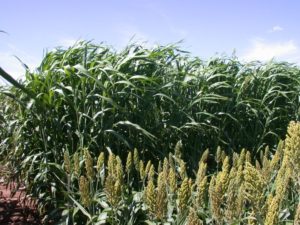Texas grain sorghum farmers have dealt with sugarcane aphid levels to varying degrees for the past five years. In grain sorghum, most seed companies now have commercial hybrids they believe have some tolerance, even resistance to sugarcane aphid. Regardless of a grain sorghum hybrid’s potential tolerance (let alone resistance) to SCA, all grain sorghums are assumed susceptible at some level and must be scouted.
What about sorghum/sudans? This forage class is popular in Texas for both grazing and haying with high potential for regrowth. This regrowth reduces production costs as you are not starting over from scratch for a new crop.
Until recently, no sorghum/sudan hybrids have been reported or marketed with known tolerance to sugarcane aphid. Most breeding effort is focused on commercial grain sorghum hybrids. In a past edition of AgriLife Row Crops Newsletter I wrote about the possibility that some hay growers might best consider hybrid pearl millet instead. HPM is considered a poor host of SCA. See https://agrilife.org/texasrowcrops/2017/06/05/hybrid-pearl-millet-as-an-alternative-to-sugarcane-aphid-susceptible-sorghums-updated/ Data from the Lubbock region in 2016 found SCA levels in hybrid pearl millet were only 0.7 to 3.0% of that in heavily infested adjacent grain sorghum. Few colonies (at least one adult and at least one juvenile, or nymph) were found in the hybrid pearl millet. I rarely saw any honeydew.
Sorghum/Sudans that Show Potential Tolerance to Sugarcane Aphid
In 2018 Warner Seeds, Hereford, TX first advertised a sorghum/sudan hybrid with tolerance to SCA. It is Grow-N-Graze “Defender.” Also, Richardson Seeds, Vega, TX noted noticeably fewer SCA in Sweeter-N-Honey II than in other sorghum/sudans. (This is not to be confused with other brands of Sweeter-N-Honey, including the brown midrib or BMR.) I placed both hybrids in my 2018 grain sorghum hybrid SCA tolerance tests and though the SCA infestations were mild, there were fewer SCA in either of these hybrids versus a standard (control) sorghum/sudan. Unfortunately, Warner recently reported that Defender is all but sold out. Richardson reports limited remaining seed.
Previously in 2017, Dr. Allen Knutson, Texas A&M AgriLife Extension entomologist, Dallas, reported sugarcane aphids were lower in Sweeter-N-Honey II as well as Super Sugar DM (Gayland Ward Seed Co.) and Sweeter-N-Honey BMR (Richardson Seeds; they have not made a claim about this being a potentially SCA-tolerant hybrid). Leaf damage on these three hybrids ranged from 10 to 14% whereas numerous other sorghum/sudan and forage sorghum hybrids had leaf damage ratings from 40 to 79%.
Sorghum/sudan hybrid Sweeter-N-Honey II in the Lubbock sorghum sugarcane aphid hybrid tolerance test, 2018.
Management of Sugarcane Aphid in Sorghum/Sudans
Because the canopy of a sorghum/sudan crop can be thick and deep, it is difficult at best to get satisfactory control of SCA in a crop with a lot of biomass. Even high pressure and 20 gallons of carrier volume per acre applied with a ground rig may not give sufficient control. (And don’t consider an airplane application.) In this situation, it may be best to either pour the cattle in and graze down the crop or hay immediately. This will not eliminate SCA. However, as crop growth resumes, you should be able to readily control SCA in the regrowth up to about 12” tall.
Sivanto and Transform are both labeled under Section 18 for sugarcane aphid control in sorghums. It appears you need to wait seven days after application of Transform to graze or hay. For Sivanto, grazing is not mentioned, but for hay the full label says seven days to haying whereas the Section 18 label for SCA (at lower rates of chemical) simply says “14 days PHI” (post-harvest interval) and does not specify grain, hay, or grazing. Check with your chemical dealer for clarification.
Silage Forage Sorghums and SCA
For further information on potential sugarcane aphid tolerance in forage sorghums (likely for silage) review the forage sorghum silage hybrid trial results from the Texas Panhandle. See Texas A&M AgriLife trial reports at https://amarillo.tamu.edu/amarillo-center-programs/agronomy/forage-sorghum/, especially the SCA tolerance ratings in 2016 and 2017. For further information contact the project coordinator Dr. Jourdan Bell, O 806.677.5600, jourdan.bell@ag.tamu.edu
Submitted by
Dr. Calvin Trostle, Extension Agronomy, TAMU Dept. of Soil & Crop Sciences, Lubbock, 806-746-6101, ctrostle@ag.tamu.edu;
May 8, 2019

